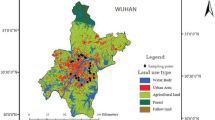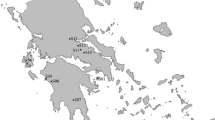Abstract
Fourteen pesticides were screened and determined through quick, easy, cheap, effective, rugged, and safe (QuEChERS) extraction process combined with GC-MS/MS in arid agriculture soil. The aims of the current investigation were to account the occurrence of organochlorine (OCP) and organophosphates (OPP) pesticide residues as well as other groups of pyrethroids (PYRs), carbamates, and biopesticides using a combined of QuEChERS and GC-MS/MS techniques in agriculture soils at Al-Kharj region, Saudi Arabia, and to investigate correlation between pesticide losses in soils and some physicochemical characteristics of pesticides including an octanol-water coefficient partition (Kow) and the vapor pressure (Vp). Prediction of pesticide fate by considering both pesticide and soil physio-chemical properties will facilitate the management of pesticide application and minimize the hazards of environmental pollution. The fate of pesticide residue in soils is generally controlled by soil/air exchange, water interaction, and biodegradation. The results indicated that 14 pesticide residues were measured in collected samples of various soils, spinosad, chlorpyrifos methyl, dimethoate, chlorpyrifos, lindane (γ-HCH), permethrin, and methomyl which were the most abundant sources of contamination in the studied region. p,p-DDT, o,p-DDT, bifenthion, β-cyfluthrin, and methidathion were less commonly detected. Single parameter least squares regression equations (sp-LSRE) for Vp and Kow against the loss of each pesticide residue showed a significant change in concentration levels (p < 0.05) between the two seasons. The results showed that vapor pressure and octanol-water partition coefficient data are not enough to model pesticide residue losses in arid low organic carbon soil. More soil-related data is needed to describe the dissipation mechanisms of these pesticide residues in the region.


Similar content being viewed by others
References
Ahmed, R., Kookana, R. S., Alston, A. M., & Skjemstad, J. O. (2001). The nature of soil organic matter affects sorption of pesticides. 1. Relationships with carbon chemistry as determined by 13C CPMAS NMR spectroscopy. Environmental Science & Technology, 35, 878–884.
Alabdula’aly, A. I., Al-Rehaili, A. M., Al-Zarah, A. I., & Khan, M. A. (2010). Assessment of nitrate concentration in groundwater in Saudi Arabia. Environmental Monitoring and Assessment, 161, 1–9.
Al-Harbi, K. M. (2010). Monitoring of agricultural area trend in Tabuk region –Saudi Arabia using Landsat TM and SPOT data. The Egyptian Journal of Remote Sensing and Space Sciences, 13, 37–42.
Al-Saleh, I., Al-Doush, I., & Echeverria-Quevedo, A. (1999). Residues of pesticides in grains locally grown in Saudi Arabia. Bulletin of Environmental Contamination and Toxicology, 63, 451–459.
Al-Saleh, I., Echeverria-Quevedo, A., Al-Dgaither, S., & Faris, R. (1998). Residue levels of organochlorinated insecticides in breast milk: a preliminary report from Al-Kharj, Saudi Arabia. Journal of Environmental Pathology, Toxicology and Oncology, 17, 37–50.
Al-Saleh, I., El Din, M. G., Al-Doush, I., Alsabbaheen, A., & Rabbah, A. (2012). Levels of DDT and its metabolites in placenta, maternal and cord blood and their potential influence on neonatal anthropometric measures. The Science of the Total Environment, 416, 62–74.
Al-Wabel, M. I., El-Saeid, M. H., Al-Turki, A. M., & Abdel-Nasser, G. (2011). Monitoring of pesticide residues in Saudi Arabian agricultural soils. Research Journal of Environmental Sciences, 5, 269–278.
Batarseh, M., & Rakan, T. (2013). Multiresidue analysis of pesticides in agriculture soil from Jordan Valley. Jordan Journal of Chemistry, 8(3), 152–168.
Benedicta, Y. F.-M., Okoffo, E. D., Darko, G., & Gordon, C. (2016, 2016). Organophosphorus pesticide residues in soils and drinking water sources from cocoa producing areas in Ghana. Environmental System Research, 5, –10.
Burkhard, N., & Guth, J. A. (1981). Rate of volatilisation of pesticides from soil surfaces: comparison of calculated results with those determined in a laboratory model system. Pesticide Science, 12, 37–44.
El-Saeid, M. H., Al-Turki, A. M., Al-Wabel, M. I., & Abdel-Nasser, G. (2011). Evaluation of pesticide residues in Saudi Arabian groundwater. Research Journal of Environmental Sciences, 5, 171–178.
EL-Saeid, M.H., Majjami, A.Y., Modaihsh A.S., Al-Barakah N.I., Fahad, G., Adel and Bazeyad, A. (2019). Impact of QuEChERS and GC-MS/MSTQD as multiresidues techniques for determination of 74 pesticides in olive farm soil. International Research Journal of Pure & Applied Chemistry, 17(4): 1–11, 2018; Article no. IRJPAC.46264 ISSN: 2231–3443, NLM ID: 10164766.
Ghafoor, A., Jarvis, N. J., Thierfelder, T., & Stenström, J. (2011). Measurements and modeling of pesticide persistence in soil at the catchment scale. Science of the Total Environment, 409, 1900–1908.
Gonzalez, M., Miglioranza, K. S. B., Aizpún, J. E., Isla, F. I., & Peña, A. (2010). Assessing pesticide leaching and desorption in soils with different agricultural activities from Argentina (Pampa and Patagonia). Chemosphere., 81, 351–358.
Goss, K. U., & Schwarzenbach, R. P. (2001). Linear free energy relationships used to evaluate equilibrium partitioning of organic compounds. Environmental Science & Technology, 35, 1–9.
Guth, J. A., Reischmann, F. J., Allen, R., Arnold, D., Hassink, J., Leake, C. R., Skidmore, M. W., & Reeves, G. L. (2004). Volatilisation of crop protection chemicals from crop and soil surfaces under controlled conditions—prediction of volatile losses from physicochemical properties. Chemosphere, 57, 871–887.
Hussen, A., Negussie, M., & Jan Ake, J. (2017). Effect of aging organochlorine pesticides in various soil types on their extractability using selective pressurized liquid extraction. Journal of Environmental Protection, 8, 867–883 http://www.scirp.org/journal/jep.
Bai, J., Lu, Q., Zhao, Q., Wang, J., Gao, Z., & Zhang, G. (2015). Organochlorine pesticides (OCPs) in wetland soils under different land uses along a 100-year chronosequence of reclamation in a Chinese estuary. Scientific Reports, 5, 17624. https://doi.org/10.1038/srep17624.
Kodeˇsovaa, R., Koˇcareka, M., Kodeš, B. V., Drabeka, O., Kozaka, J., & Hejtmankovac, K. (2011). Pesticide adsorption in relation to soil properties and soil type distribution in regional scale. Journal of Hazardous Materials, 186, 540–550.
Luo, Y., Yang, R., Li, Y., Wang, P., Zhu, Y., Yuan, G., Zhang, Q., & Jiang, G. (2019). Accumulation and fate processes of organochlorine pesticides (OCPs) in soil profiles in Mt. Shergyla, Tibetan Plateau: a comparison on different forest types. Chemosphere., 231, 571–578. https://doi.org/10.1016/j.chemosphere.
Mackay, D., Shui, W. Y., & Ma, K. C. (1997). Illustrated Handbook of Physical-Chemical Properties and Environmental Fate of Organic chemicals (pp. 351–374). Boca Raton: Lewis Publishers.
Osman, K. A., Al-Humaid, A. I., Al-Rehiayani, A. I., & Al-Redhaiman, K. N. (2010). Monitoring of pesticide residues in vegetables marketed in Al-Qassim region, Saudi Arabia. Ecotoxicology and Environmental Safety, 73, 1433–1439.
Reichman, R., Mehrer, Y. A., &; Wallach, R. A. (2000a). Combined soil-atmosphere model for evaluating the fate of surface-applied pesticides. 2. The effect of varying environ- mental conditions. Environmental Science & Technology, 34, 1321–1330.
Reichman, R., Wallach, R., & Mehrer, Y. A. (2000b). Combined soil-atmosphere model for evaluating the fate of surface- applied pesticides. 1. Model development and verification. Environmental Science & Technology, 34, 1313–1320.
Sara Andrea Vaca Sanchez, Axel Mentler, Michael Gartner, Andreas Gschaider, Joep van der Poel, Rosana Maria Kral, Asih Ngadisih, and Katharina Maria Keiblinger (2019). Pesticide residues in intensive agricultural soils are higher than inagroforestry systems – a case study on the Indonesian Dieng plateau. Geophysical Research Abstracts Vol. 21, EGU2019–12351
Scholtz, M. T., & Bidleman, T. F. (2007). Modelling of the long-term fate of pesticide residues in agricultural soils and their surface exchange with the atmosphere: Part II.Projected long-term fate of pesticide residues. The Science of the Total Environment, 377, 61–80.
Sheta, A. S., AI-Sewailem, M. S., Sallam, A. S., & Al-Mashhady, A. S. (2000). Nature and composition of newly formed precipitates in relationship to characteristics of groundwater in arid environment. Arid Soil Research and Rehabilitation, 14, 387–401.
Ssebugere, P., Wasswa, J., Mbabazi, J., Nyanzi, S. A., Kiremire, B. T., & Marco, J. A. M. (2010). Organochlorine pesticides in soils from South-Western Uganda. Chemosphere., 78, 1250–1255.
Wang, X., Wang, D., Qin, X., & Xu, X. (2008). Residues of organochlorine pesticides in surface soils from college school yards in Beijing. Chinese Journal of Environmental Science, 20, 1090–1096.
Wesenbeeck, I. V., Driver, J., & Ross, J. (2008). Relationship between the evaporation rate and vapor pressure of moderately and highly volatile chemicals. Bulletin of Environmental Contamination and Toxicology, 80, 315–318.
Woodrow, J. E., Seiber, J. N., & Baker, L. W. (1997). Correlation techniques for estimating pesticide volatilization flux and downwind concentrations. Environmental Science & Technology, 31, 523–529.
Woodrow, J. E., Seiber, J. N., & Dary, C. (2001). Predicting pesticide emissions and downwind concentrations using correlations with estimated vapor pressures. Journal of Agricultural and Food Chemistry, 49, 3841–3847.
Gill, H. K., & Garg, H. (2014). Pesticide: environmental impacts and management strategies. Pesticides-toxic aspects, 8, 187.
Acknowledgments
This article was supported by Deanship of Scientific Research, King Saud University, Riyadh, Saudi Arabia, research group no. RGP-1440-050.
Author information
Authors and Affiliations
Corresponding author
Additional information
Publisher’s Note
Springer Nature remains neutral with regard to jurisdictional claims in published maps and institutional affiliations.
Electronic Supplementary Material
ESM 1
(DOCX 13 kb)
Rights and permissions
About this article
Cite this article
EL-Saeid, M.H., Alghamdi, A.G. Identification of Pesticide Residues and Prediction of Their Fate in Agricultural Soil. Water Air Soil Pollut 231, 284 (2020). https://doi.org/10.1007/s11270-020-04619-6
Received:
Accepted:
Published:
DOI: https://doi.org/10.1007/s11270-020-04619-6




